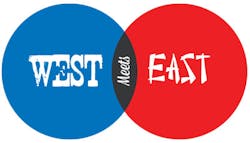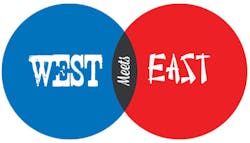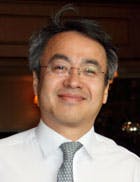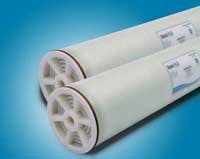Life's Good for Team South Korea/America
Earlier this year Californian membrane company NanoH2O was acquired by South Korea's LG Chem. In a "West meets East" merge, what will the combined business mean for the competitive membrane market? We speak to president Chul Nam to find out.
By Tom Freyberg
At the end of 2011 WWi reported on what could be called the water industry's "Cinderella" story. The headline read: Commercialising Desalination's Holy Grail: Low Cost, High Flux Membranes.
It documented how, in five years a Californian start up commercialised a university R&D project and attracted $35 million investment. At the time critics may have thought this story was too good to be true. Yet this same company – NanoH2O – continued expanding.
Since then it has achieved 300 membrane references globally and invested $45 million into a manufacturing site in Liyang, China. Fast forward to the middle of March 2014 and rumours spread that the US company was to be acquired by South Korean-based LG Chem – the same group as the well known electronics company, LG.
New sources including Businessweek and the Yonhap News Agency reported that LG Chem had revealed the plan in a filing to the Korea Exchange.
Two months later and the two companies confirmed the reports. Although the purchase sum was not disclosed (earlier reports suggested US$200 million), the acquired company would become known as LG NanoH2O.
Taking the Top Spot
In an East meets West merge, the new company does not hold back on its ambition.
Speaking to WWi, Chul Nam, president of LG NanoH2O, says: "We believe the synergy between LG Chem and NanoH2O will propel to us to become the market leader in the RO business.
"Our catchphrase is business is to be global number one," he adds. "When we launch a new business our objective is always to be the number one globally. That's very clear. Our strategy includes development of innovative products and a global sales and service network.
"LG Chem is now a leader in thin film coating technology, which is a strategic advantage over our competitors. In addition, we are well linked to large scale manufacturing facility in Korea, with future expansion plans into China as well."
One aim behind the merge is that the companies will increase market share in the reverse osmosis (RO) market. This will be engineered by tapping into NanoH2O's intellectually property, combining it with LG Chem's R&D efforts and combining sales channels from both organisations. Potentially, it's a very powerful combination.
To put LG Chem into perspective, it was founded in 1947 as a chemical business, and is one of 62 subsidiary companies of the LG Group. LG Chem is a listed company, like LG Electronics, but they act as totally independent companies.
In 2013 LG Chem generated a turnover of $22 billion, from products sold into the petrochemicals market to battery manufacturing.
Tapping into China
Moving forward, Nam believes the biggest growth for the company will come from brackish water and China.
"Brackish water, especially industrial applications of wastewater reuse now account for 60% of the entire RO market," says Nam. "To maintain operation sustainability we must get into the brackish seawater product market, especially for industrial water applications. We will focus in the beginning on petrochemical, oil & gas and wastewater reuse. As you know the biggest water for the brackish water is now China. We believe we are very strong in China, especially with our sales force networks."
The president says the firm has finished development of brackish water products and China will be the biggest target market for these. "Anti-fouling technology" has also been applied to the membranes. They hope to start pilot applications and testing in China, Europe and America this Autumn.
"We had already developed anti-fouling products in LG Chem prior to taking over Nano H2O," adds Nam. "So we will apply LG Chem's own anti-fouling technology on this product line."
Development of Graphene and Material Science
University research on graphene – a material said to be stronger than steel – for use in water filtration continues to gather pace. Massachusetts Institute of Technology (MIT) researchers have been working on this for five years.
Meanwhile Lockheed Martin engineers, under the trademark Perforene, have received four patents covering graphene membranes.
With graphene being one of the membrane industry's hottest topics, where does LG Nano H2O stand on its development?
"As far as I understand many of these university projects on new materials are showing improved performance in the lab," admits Nam. "All of these type of materials show great promise in the laboratory but there's a big difference between lab scale and mass production scale. But consideration of new materials such as graphene and carbon nanotubes and performance innovation will occur in the next generation. "
Nam says they are working with universities in South Korea and that "our continuous investment into R&D, including material science, is one of our core strategies".
Future Investment and Conclusion
It was at the end of 2010 when LG announced it would be investing US$400 up until 2020 to enter the water treatment market and develop an advanced membrane filtration system.
So if the earlier reports are to be believed and LG Chem spent $200 million buying the Californian company, this would leave a further $200 million for investment. How will this be spent?
"In the near future further mass production plants and R&D will be the main investment areas," says Nam enthusiastically. "After this we will invest more resources especially for capacity expansion in Korea and China as well. However, all investment depends on our performance, success and commitment."
Becoming the sought after "number one" is not just a LG philosophy but a South Korean one, it seems. From the legend that ex-Samsung CEO GS Choi spent two decades chasing Sony to become the number one TV brand, to the company overtaking Apple in the smartphone manufacturing race: the drive for global supremecy seems inherent in South Korea's genetics.
While the television and smart phone war has become fiercely competitive, so has the membrane arena, particularly in China. WWi understand there to be at least 800 companies in this country alone.
By combining NanoH2O's technology and reputation, with a South Korean chemical giant's distribution channels and R&D army, the new combined company will no doubt continue to climb in one direction.
Tom Freyberg is chief editor of WWi magazine. For more information on the article, email: [email protected]




